托福阅读天文类背景补充
- 格式:pptx
- 大小:8.65 MB
- 文档页数:33
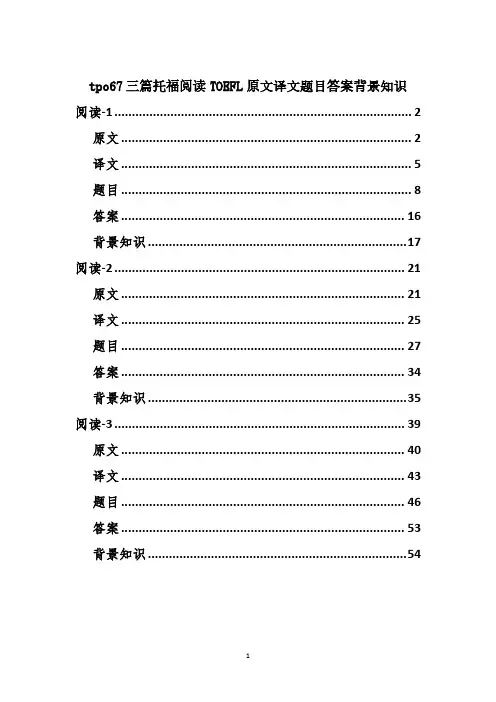
tpo67三篇托福阅读TOEFL原文译文题目答案背景知识阅读-1 (2)原文 (2)译文 (5)题目 (8)答案 (16)背景知识 (17)阅读-2 (21)原文 (21)译文 (25)题目 (27)答案 (34)背景知识 (35)阅读-3 (39)原文 (40)译文 (43)题目 (46)答案 (53)背景知识 (54)阅读-1原文Crop Engineering①Our current ability to precisely engineer crop genomes was preceded by a long history of genetic manipulation in agriculture. Human impact and its accompanying effects began early in our history at many tropical and subtropical sites around the globe.Our ancestors were omnivores,consuming whatever plant or animal material they fortuitously encountered.Even then,humans had considerable effects on the environment,reducing and even driving to extinction populations of the animal species they hunted and expanding the distribution of plants by accidentally distributing seeds as they migrated.②Humans probably first realized that seeds could yield a stable food supply through agriculture when they observed plants arising from refuse or wasteland,perhaps fruit trees growing along forest and jungle paths from discarded or defecated seeds or else vegetables sprouting in garbage dumps at temporary settlements.A more organized approach to agriculture began about eight to ten thousandyears ago coincidentally at a number of locations around the globe. The most diverse farming developed in the Near East,with legumes, cereals,flax,sesame,and fruit trees.At about the same time,New World residents were growing beans,maize,squashes,and potatoes,and Asian farmers were beginning to cultivate rice.③These early domesticated crops foreshadowed the overwhelming changes contemporary agriculture has wrought in plants.Humans soon learned to separate varieties that could be grown as crops from wild types in order to prevent characteristics undesirable for cultivation from mingling with those selected for farming.Continued selection of crops with desirable characteristics increased the separation between feral(wild)and managed plants and accelerated the diminishing diversity and more limited variation found in today's crops.④The simplest way to select crops is to save seeds preferentially from plants with beneficial traits,and the first farmers selected for large seeds and fruit,increased seed production,lack of dormancy,faster germination,higher annual yield,and reduced seed scattering.The success of this early selection resulted in an accelerating impact ofagriculture on crop diversity and feral plants.Crops quickly became commodities,moved and traded over a rapidly widening area,so that many plants were distributed well beyond their previous ranges,and some throughout the globe.⑤Three phenomena have characterized the more recent impact of agriculture on Earth.The first was the increase in human population, which has doubled at shorter and shorter intervals over the last thousand years.The result was increased acreage under cultivation and a fundamental remodeling of the globe toward managed rather than wild ecosystems.By1998there were3,410,523,800acres of land under cultivation worldwide,an area larger than the United States. Entire ecosystems have disappeared,others remain but are threatened, and the sheer volume of people and area of farmland have been major forces of biological change.⑥The second event through which agriculture modified our planet was European colonization.Previously,migration and trade had moved crops between countries and continents,but the Europeans inaugurated an unprecedented dispersal of biological materialworldwide.Maize,tomatoes,and potatoes were transported from the New World to the Old;wheat,rye,and barley were carried from the Old World to the New;and rice,soybeans,and alfalfa were moved from their Asian sources to every arable continent.Each of these and innumerable other introductions conveyed not only unique material but also assemblages of introduced plant pests and diseases that today cause the majority of pest-management problems around the world.⑦The third factor shaping the nature of agriculture and the environment alike is the increasing precision with which we have selected and bred crops.This acuity stemmed from many advances, but at its heart lies the work of two men—one,the English naturalist Charles Darwin,and the other,an Austrian monk,Gregor Mendel.The concepts of evolution and genetics were not their work alone,but both of them were decades ahead of their colleagues in synthesizing the companion concepts of natural selection and inheritance that are at the core of all contemporary biological science and that form the substrate upon which biotechnology grew.译文作物工程①我们目前能准确设计农作物基因组的能力是由在农业中长期的基因操控得来的。
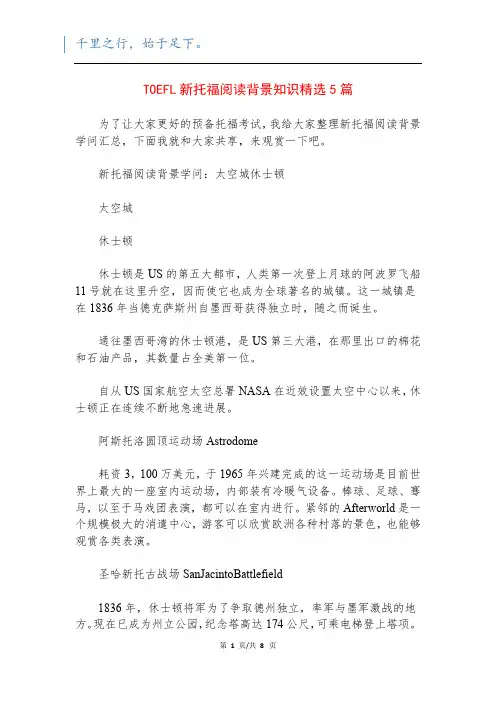
TOEFL新托福阅读背景知识精选5篇为了让大家更好的预备托福考试,我给大家整理新托福阅读背景学问汇总,下面我就和大家共享,来观赏一下吧。
新托福阅读背景学问:太空城休士顿太空城休士顿休士顿是US的第五大都市,人类第一次登上月球的阿波罗飞船11号就在这里升空,因而使它也成为全球著名的城镇。
这一城镇是在1836年当德克萨斯州自墨西哥获得独立时,随之而诞生。
通往墨西哥湾的休士顿港,是US第三大港,在那里出口的棉花和石油产品,其数量占全美第一位。
自从US国家航空太空总署NASA在近效设置太空中心以来,休士顿正在连续不断地急速进展。
阿斯托洛圆顶运动场Astrodome耗资3,100万美元,于1965年兴建完成的这一运动场是目前世界上最大的一座室内运动场,内部装有冷暖气设备。
棒球、足球、骞马,以至于马戏团表演,都可以在室内进行。
紧邻的Afterworld是一个规模极大的消遣中心,游客可以欣赏欧洲各种村落的景色,也能够观赏各类表演。
圣哈新托古战场SanJacintoBattlefield1836年,休士顿将军为了争取德州独立,率军与墨军激战的地方。
现在已成为州立公园,纪念塔高达174公尺,可乘电梯登上塔项。
塔下是历史博物馆。
距休士顿市约26公里。
US航空太空总署太空飞行中心NASAMannedSpacecraft因阿波罗11号在此升空而全球著名。
US国家航空太空总署NASA于1961年设立于休士顿东南方45公里处的克利阿湖畔。
四周有GeneralElectric和InternationalBusinessMachines等重要的电子工业企业,是名符其实的航空太空科学中心。
展览馆Exhibit Hall的一号馆中,陈设着太空飞行员使用的器具、太空食物、太空船模型、月球上采集的岩石,对一般观光客公开。
太空飞行中心内部极为宽阔,可在进入中心的问讯处索取地图,备作参考。
太空中心内也有礼品店,出售太空船模型、月球石头模型,以及阿波罗帽等。
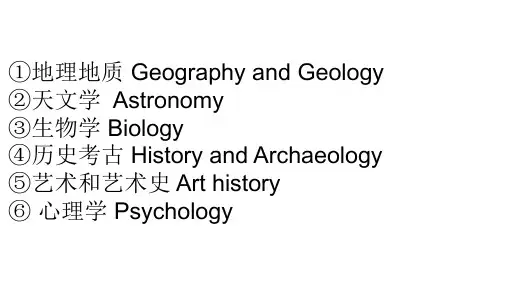
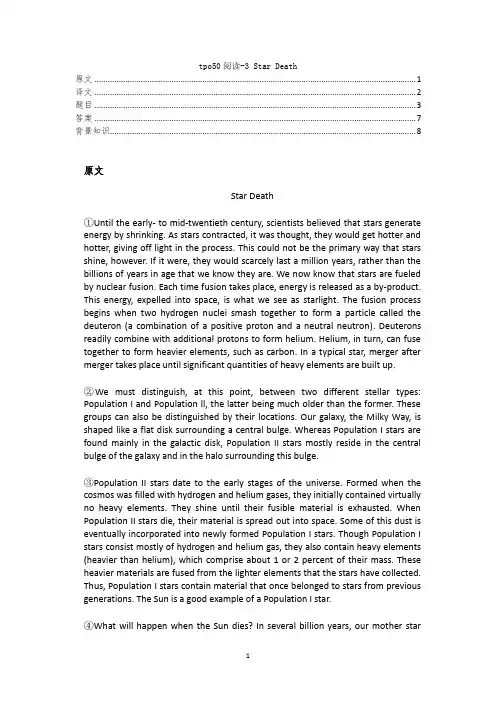
tpo50阅读-3 Star Death原文 (1)译文 (2)题目 (3)答案 (7)背景知识 (8)原文Star Death①Until the early- to mid-twentieth century, scientists believed that stars generate energy by shrinking. As stars contracted, it was thought, they would get hotter and hotter, giving off light in the process. This could not be the primary way that stars shine, however. If it were, they would scarcely last a million years, rather than the billions of years in age that we know they are. We now know that stars are fueled by nuclear fusion. Each time fusion takes place, energy is released as a by-product. This energy, expelled into space, is what we see as starlight. The fusion process begins when two hydrogen nuclei smash together to form a particle called the deuteron (a combination of a positive proton and a neutral neutron). Deuterons readily combine with additional protons to form helium. Helium, in turn, can fuse together to form heavier elements, such as carbon. In a typical star, merger after merger takes place until significant quantities of heavy elements are built up.②We must distinguish, at this point, between two different stellar types: Population I and Population ll, the latter being much older than the former. These groups can also be distinguished by their locations. Our galaxy, the Milky Way, is shaped like a flat disk surrounding a central bulge. Whereas Population I stars are found mainly in the galactic disk, Population II stars mostly reside in the central bulge of the galaxy and in the halo surrounding this bulge.③Population II stars date to the early stages of the universe. Formed when the cosmos was filled with hydrogen and helium gases, they initially contained virtually no heavy elements. They shine until their fusible material is exhausted. When Population II stars die, their material is spread out into space. Some of this dust is eventually incorporated into newly formed Population I stars. Though Population I stars consist mostly of hydrogen and helium gas, they also contain heavy elements (heavier than helium), which comprise about 1 or 2 percent of their mass. These heavier materials are fused from the lighter elements that the stars have collected. Thus, Population I stars contain material that once belonged to stars from previous generations. The Sun is a good example of a Population I star.④What will happen when the Sun dies? In several billion years, our mother starwill burn much brighter. It will expend more and more of its nuclear fuel, until little is left of its original hydrogen. Then, at some point in the far future, all nuclear reactions in the Sun’s center will cease.⑤Once the Sun passes into its "postnuclear" phase, it will separate effectively into two different regions: an inner zone and an outer zone. While no more hydrogen fuel will remain in the inner zone, there will be a small amount left in the outer zone. Rapidly, changes will begin to take place that will serve to tear the Sun apart. The inner zone, its nuclear fires no longer burning, will begin to collapse under the influence of its own weight and will contract into a tiny hot core, dense and dim. An opposite fate will await the outer region, a loosely held-together ball of gas. A shock wave caused by the inner zone's contraction will send ripples through the dying star, pushing the stellar exterior's material farther and farther outward. The outer envelope will then grow rapidly, increasing, in a short interval, hundreds of times in size. As it expands, it will cool down by thousands of degrees. Eventually, the Sun will become a red giant star, cool and bright. It will be so large that it will occupy the whole space that used to be the Earth's orbit and so brilliant that it would be able to be seen with the naked eye thousands of light-years away. It will exist that way for millions of years, gradually releasing the material of its outer envelope into space. Finally, nothing will be left of the gaseous exterior of the Sun; all that will remain will be the hot, white core. The Sun will have become a white dwarf star. The core will shrink, giving off the last of its energy, and the Sun will finally die.译文恒星的消亡①直到二十世纪中叶之前,科学家们一直认为恒星通过收缩来产生能量。

托福天文一、背景知识天文学是研究宇宙中恒星、行星、银河等天体及其相互关系的科学。
它既是一门古老的科学,也是一门现代化的科学。
托福考试中的“托福天文”任务主要考察对天文学基本概念和相关知识的理解和应用能力。
1. 天体观测与测量天文学家通过观测和测量来研究宇宙中的各种现象。
观测手段包括使用望远镜观察可见光、红外线、紫外线等电磁波,以及利用射电望远镜观察射电波。
测量手段包括使用角度测量来确定星体位置和运动,利用光谱分析来研究物质组成和性质等。
2. 星系与银河系星系是由恒星、行星、气体和尘埃等组成的巨大集合体,它们通过引力相互束缚在一起。
银河系是地球所在的一个星系,其中包含数十亿颗恒星以及大量气体和尘埃。
银河系的形状类似于一个扁平的旋涡,其中心有一个巨大的黑洞。
3. 恒星与行星恒星是宇宙中的光源,它们通过核聚变反应产生巨大的能量,并向周围空间释放光和热。
恒星根据质量和亮度可以分为不同类型,如红巨星、白矮星、中子星和黑洞等。
行星是绕恒星运行的天体,根据距离恒星的远近可以分为内行星和外行星。
4. 宇宙演化与宇宙学宇宙演化是指宇宙从诞生到现在的发展过程。
科学家通过观测和理论模型推测了宇宙大爆炸后的演化历程,包括暗物质、暗能量、黑洞等重要概念。
而宇宙学则是研究整个宇宙的起源、结构和演化规律等问题。
二、任务要求托福天文任务要求考生对天文学基本概念和相关知识有较深入的理解,并能将其应用于解决实际问题。
因此,在准备托福天文任务时,考生应注重以下几点:1. 学习基本概念学习天文学的基本概念是理解和应用天文知识的基础。
例如,了解恒星的分类和演化过程、行星的组成和运动规律、宇宙大爆炸理论等。
2. 熟悉观测和测量方法观测和测量是天文学家研究宇宙的重要手段。
熟悉望远镜的使用、角度测量和光谱分析等方法,可以帮助考生更好地理解观测数据和科学研究成果。
3. 阅读相关科普材料阅读相关科普材料可以帮助考生扩展对天文学知识的了解,同时提高阅读理解能力。
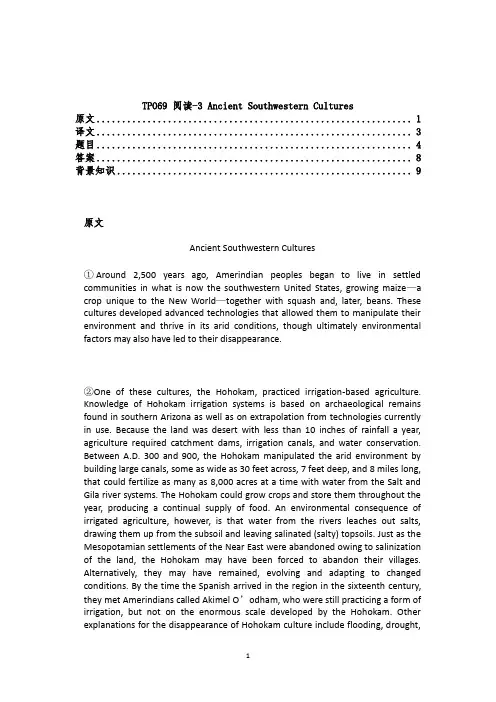
TPO69 阅读-3 Ancient Southwestern Cultures原文 (1)译文 (3)题目 (4)答案 (8)背景知识 (9)原文Ancient Southwestern Cultures①Around 2,500 years ago, Amerindian peoples began to live in settled communities in what is now the southwestern United States, growing maize—a crop unique to the New World—together with squash and, later, beans. These cultures developed advanced technologies that allowed them to manipulate their environment and thrive in its arid conditions, though ultimately environmental factors may also have led to their disappearance.②One of these cultures, the Hohokam, practiced irrigation-based agriculture. Knowledge of Hohokam irrigation systems is based on archaeological remains found in southern Arizona as well as on extrapolation from technologies currently in use. Because the land was desert with less than 10 inches of rainfall a year, agriculture required catchment dams, irrigation canals, and water conservation. Between A.D. 300 and 900, the Hohokam manipulated the arid environment by building large canals, some as wide as 30 feet across, 7 feet deep, and 8 miles long, that could fertilize as many as 8,000 acres at a time with water from the Salt and Gila river systems. The Hohokam could grow crops and store them throughout the year, producing a continual supply of food. An environmental consequence of irrigated agriculture, however, is that water from the rivers leaches out salts, drawing them up from the subsoil and leaving salinated (salty) topsoils. Just as the Mesopotamian settlements of the Near East were abandoned owing to salinization of the land, the Hohokam may have been forced to abandon their villages. Alternatively, they may have remained, evolving and adapting to changed conditions. By the time the Spanish arrived in the region in the sixteenth century, they met Amerindians called Akimel O’odham, who were still practicing a form of irrigation, but not on the enormous scale developed by the Hohokam. Other explanations for the disappearance of Hohokam culture include flooding, drought,earthquakes, and deforestation.③A second group of southwestern peoples, the Anasazi, also developed advanced technologies for manipulating their environment. They constructed large multistoried communal houses in villages, or pueblos, along the edges of a river in the bottom of New Mexico’s Chaco Canyon where they planted crops. The communities consisted of many small villages with larger central cities containing four-story apartments and ramrod-straight roads that linked Chaco Canyon with other communities in the Southwest.④One Anasazi pueblo, Mesa Verde, illustrates the sophistication with which these peoples transformed their environment. Mesa Verde is situated 7,000 to 8,000 feet above sea level on a vast forested plateau into which erosion has cut numerous steep-walled canyons. Mesa Verde culture and agriculture developed gradually over time. The people of the earliest culture, from around A.D 500 to 750, were basket weavers who lived underground in pit houses. Around A.D 750 to 1100, they added ceremonial chambers called kivas and began building houses above ground out of bricks. Between A.D 1100 and 1300, they reached the peak of their complex culture, building ladders ascending to the cliff areas as well as pathways descending to agricultural fields in the valleys. The vast agricultural network covered some 80 square miles of development, supporting numerous pueblos located about 1,800 to 2,000 feet above the river.⑤Not only did the Anasazi build roads and pueblos, they also put their understanding of astronomy to practical use. In particular, the Anasazi attained the ability to predict the advent of growing and harvesting seasons based on arrival of solstices (longest and shortest days) around June 21 and December 21 and equinoxes (days with equal periods of light and darkness) around March 21 and September 23. They did so by building an observatory on Fajada Butte in Chaco Canyon, a stone-slab structure assembled so that on solstices and equinoxes, a sliver of sunlight entered between two stones and fell on a petroglyph (an image carved onto a rock) in a characteristic way. With this knowledge they gained a measure of control over the hazards of an arid environment.⑥The Anasazi disappeared from their homeland at the height of their cultural development around the end of the thirteenth century. Deforestation, socialdisruption,and the onset of an 11-year drought around A.D. 1280 (as evidenced by the narrowness of tree-ring growth) may have been factors leading to the abandonment of the pueblos.译文古代西南文化①大约2500年前,美洲印第安人开始生活在定居社区中(现在的美国西南部地区),种植着玉米(新世界特有的一种作物)、南瓜以及后来的豆类。
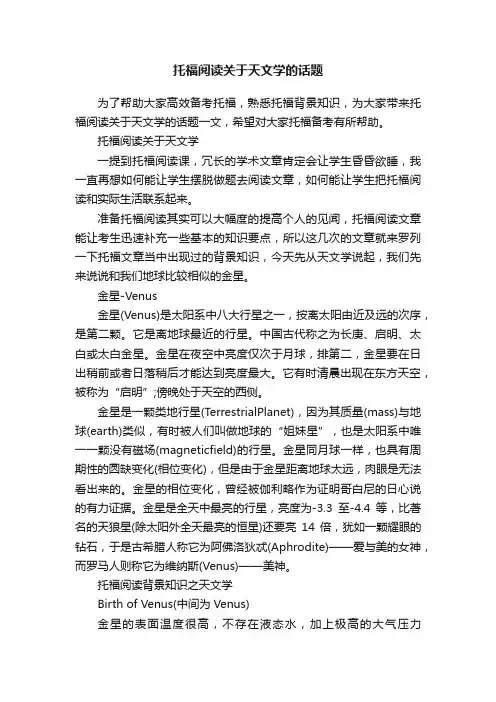
托福阅读关于天文学的话题为了帮助大家高效备考托福,熟悉托福背景知识,为大家带来托福阅读关于天文学的话题一文,希望对大家托福备考有所帮助。
托福阅读关于天文学一提到托福阅读课,冗长的学术文章肯定会让学生昏昏欲睡,我一直再想如何能让学生摆脱做题去阅读文章,如何能让学生把托福阅读和实际生活联系起来。
准备托福阅读其实可以大幅度的提高个人的见闻,托福阅读文章能让考生迅速补充一些基本的知识要点,所以这几次的文章就来罗列一下托福文章当中出现过的背景知识,今天先从天文学说起,我们先来说说和我们地球比较相似的金星。
金星-Venus金星(Venus)是太阳系中八大行星之一,按离太阳由近及远的次序,是第二颗。
它是离地球最近的行星。
中国古代称之为长庚、启明、太白或太白金星。
金星在夜空中亮度仅次于月球,排第二,金星要在日出稍前或者日落稍后才能达到亮度最大。
它有时清晨出现在东方天空,被称为“启明”;傍晚处于天空的西侧。
金星是一颗类地行星(TerrestrialPlanet),因为其质量(mass)与地球(earth)类似,有时被人们叫做地球的“姐妹星”,也是太阳系中唯一一颗没有磁场(magneticfield)的行星。
金星同月球一样,也具有周期性的圆缺变化(相位变化),但是由于金星距离地球太远,肉眼是无法看出来的。
金星的相位变化,曾经被伽利略作为证明哥白尼的日心说的有力证据。
金星是全天中最亮的行星,亮度为-3.3至-4.4等,比著名的天狼星(除太阳外全天最亮的恒星)还要亮14倍,犹如一颗耀眼的钻石,于是古希腊人称它为阿佛洛狄忒(Aphrodite)——爱与美的女神,而罗马人则称它为维纳斯(Venus)——美神。
托福阅读背景知识之天文学Birth of Venus(中间为Venus)金星的表面温度很高,不存在液态水,加上极高的大气压力(atmosphericpressure)和严重缺氧等残酷的自然条件,金星有极少的可能有生命的存在。